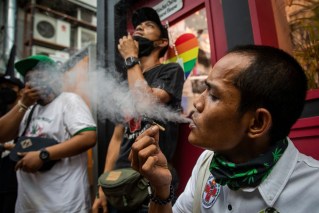Hundreds of animals in Bali and Lombok are being exploited for tourists’ entertainment, an animal welfare charity claims.
The Holidays that Harm report by World Animal Protection states more than 1300 animals were exploited for tourist entertainment in inadequate conditions across Bali and Lombok.
The animals included elephants, orangutans and dolphins.
The recent report covered 34 venues in Bali and Lombok to provide a snapshot of the welfare of animals being used in the tourism industry.
World Animal Protection says it found the majority of the venues it assessed “didn’t even meet the basic needs of the wild animals being kept there”.
“What may be an island paradise for tourists is a captive hell for more than a thousand wild animals trapped in shockingly inadequate conditions across wildlife entertainment venues in Bali and Lombok,” the head of campaigns at World Animal Protection, Suzanne Milthorpe, said.
“People go to these venues because they love animals, but they are unaware of the hidden cruelty behind the scenes, with many animals taken from their mothers as babies and forced to endure cruel and intensive training to make them ‘safe’ to interact with tourists.
“During our investigation we saw wild animals suffering for selfies, and it’s driven by tourist demand and lack of ethical policies by travel companies.”
In 2017, World Animal Protection released an assessment into the wildlife entertainment industry in Bali and Lombok.
That investigation led to companies like Helloworld and Flight Centre removing certain venues and completely ceasing promotions of rides aboard elephants.
A dedicated elephant camp and three dolphin facilities in Indonesia have been closed since 2017, the charity said.

Animals are kept in captivity for the sake of tourism. Photo: World Animal Protection
“We urge the tourism industry to take responsibility for the activities they promote, and work with us towards a future where tourism is responsible, sustainable, and does not contribute to wildlife cruelty,” Ms Milthorpe said.
“Governments must also introduce breeding bans to ensure the current generation of wild animals in captivity is the last to suffer this fate.”
Ms Milthorpe acknowledged there has been a shift in attitudes from around the world regarding entertainment, with people wanting to do the right thing.
Still, it can be hard to do the right thing, with enticing offers and a lack of travel company policies making it difficult to make an informed decision, plus overtourism and misleading conservation claims, she said.
“As a good rule of thumb – if you can ride, hug or have a selfie with a wild animal, there is cruelty involved, so don’t do it,” she said.
Harmful animal tourism around the world
Animal welfare concerns in the tourism sector are not limited to Bali and Lombok.
The elephant tourism industry across south-east Asia has been under much scrutiny in the past.
Earlier this year, Wildlife Friends Foundation Thailand (WFFT) shared a picture of an elephant that had been involved in the elephant tourism industry for years.
In the picture shared by the foundation below, Pai Lin’s back is completely disfigured after she carried several people on her back for years.
“Pai Lin’s back still bears scars from old pressure points,” the group said according to CNN.
“This continuous pressure on (elephants’) bodies can deteriorate the tissue and bones on their back, causing irreversible physical damage to their spines.”
Edwin Wiek, the director and founder of WFFT told CNN that Pai Lin came to the sanctuary in 2006, after her owner gave her up because the pain slowed her down.
Tweet from @_dheerajrakho
There were also concerns for otters that were brought to Japan illegally and kept in small cages without water or adequate food, all for the sake of “otter cafes”.
World Animal Protection has also raised concerns about experiences in southern Africa, where people can walk with lion cubs.
For this to happen, cubs are taken from their mothers shortly after their birth to supply the industry. Tourists can then take photos with them, hold them and walk with them when they get too big to hold.
However, because these cubs are bred in captivity, they cannot be released back into the wild.
Europe
For years there was a push to ban live animals from being part of circus performances in Europe.
Many European countries have banned or restricted wild animals in circuses.
Even in Australia, there has been a push to ban hugging koalas in the remaining states where it is still legal.
“The reality is that people pay to cuddle a koala because they love them, but they are unaware of the silent suffering these animals endure,” Ben Pearson, country director, World Animal Protection said last year.
“Forced visitor interactions with an animal like a koala simply adds a layer of cruelty to their life of captivity.
“There is a reason koala cuddling has been banned in several other states. The idea of using a koala as a photo prop is reflective of our broken relationship with animals and the natural world.”









